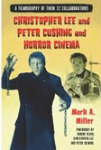Christopher Lee and Peter Cushing and Horror Cinema
Mark A. Miller
Published by McFarland Books
Review by Tim Janson
Like Karloff and Lugosi, the names Christopher Lee and Peter Cushing are synonymous with horror. The pair made 22 films together (far more than Karloff and Lugosi) although some may be surprised to know that not all of them were in the horror genre. Their work is celebrated in this new book from McFarland & Company, always a leader in scholarly film books.
Mark A. Miller, English teacher and writer for publications such as Filmfax and Shivers, looks at the pair’s career in detail and with a thorough analysis if each of their films. One can say that Karloff and Lugosi passed the horror team torch on to the pair in more ways than one. As Miller notes in the introduction, Karloff and Lee made three films together including The Crimson Altar (1968) and Corridors of Blood (1958). The pair became close friends and even played cricket together.
Miller begins with chapters devoted to the early lives of each actor. We learn about their childhoods, families, education, personal lives, and what drew them into careers as actors. Lee, born in London but of Italian ancestry, can trace his family’s roots back to the time of Christ. Despite having several family members who were actors, Cushing was into his thirties before he began his own theatrical career. Of all things, the refined British actor was a big fan of early Western film star, Tom Mix.
As mentioned, not all of their collaborations were in the horror genre. In fact, their first teaming was a production of Shakespeare’s Hamlet in 1948. Perhaps even more amusing was their second pairing, the 1952 romantic musical, Moulin Rouge. However it would be their next two pairings that would eventually make legends of Lee and Cushing, 1957’s The Curse of Frankenstein and 1958’s Horror of Dracula. These two films teamed the pair with England’s Hammer Studios for whom they would make 8 films together, and many more on their own. These films, and the sequels that followed returned horror to the gothic roots of Universal Studio’s films of the 1930s and 1940s.
Miller provides a detailed synopsis, background, and critical analysis of each of their 22 films and has done a remarkable job of research. There are wonderful anecdote’s about each film’s production, and included are comments by the actors themselves as well as period reviews from critics. Miller shares his expert view on what worked … and didn’t work with each of the films, breaking down directorial and casting selections, and examining key scenes. A complete filmography is included with a complete list of credits for each film, year of release, and running time.
About the only mild criticism I would lob is that it would have been nice to have a few more photos and perhaps some color photos, but this is minor. Miller has done outstanding job of covering this immortal team and their films. Grade A









